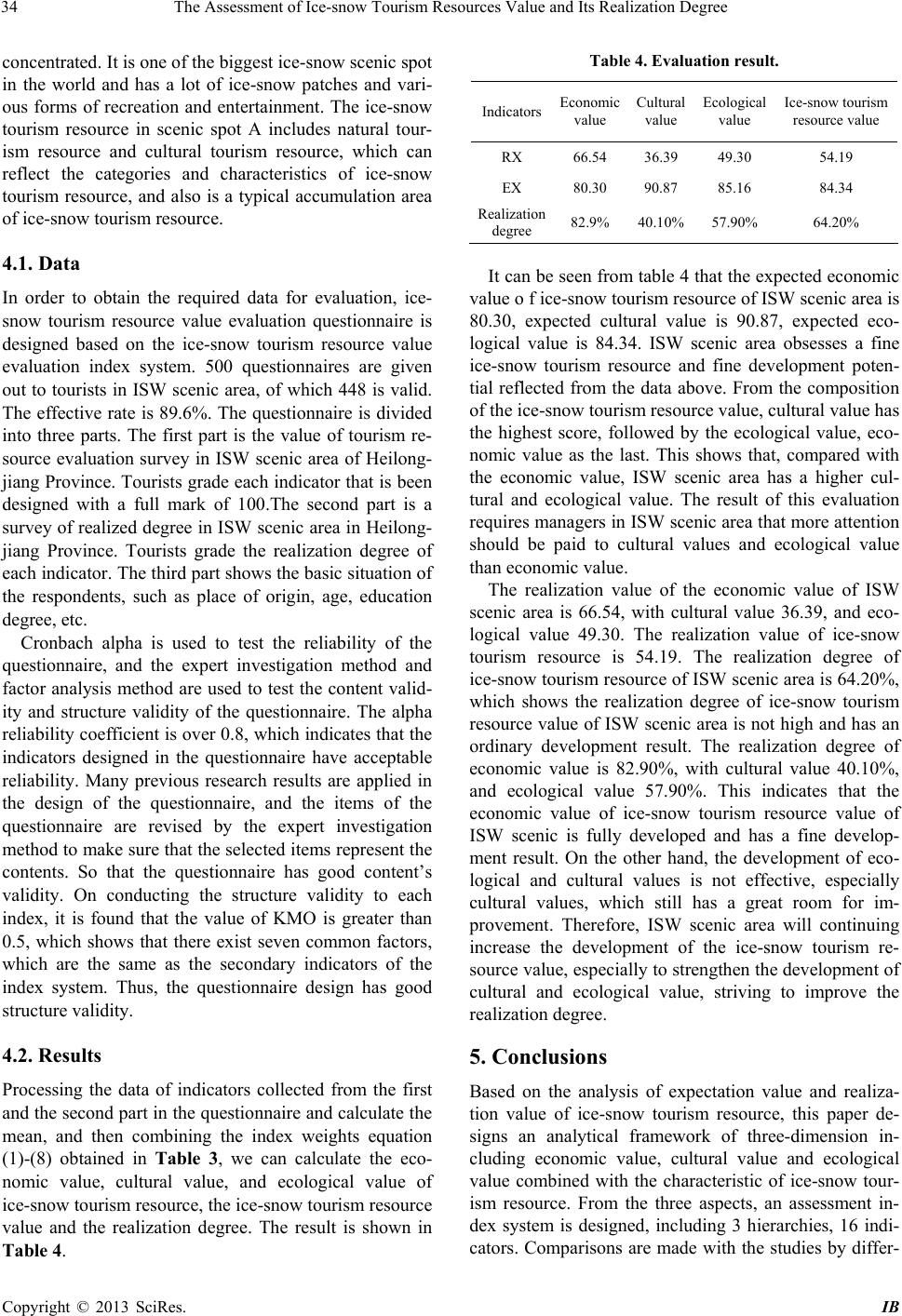
The Assessment of Ice-snow Tourism Resources Value and Its Realization Degree
34
concentrated. It is one of the biggest ice-snow scenic spot
in the world and has a lot of ice-snow patches and vari-
ous forms of recreation and entertainment. The ice-snow
tourism resource in scenic spot A includes natural tour-
ism resource and cultural tourism resource, which can
reflect the categories and characteristics of ice-snow
tourism resource, and also is a typical accumulation area
of ice-snow tourism resource.
4.1. Data
In order to obtain the required data for evaluation, ice-
snow tourism resource value evaluation questionnaire is
designed based on the ice-snow tourism resource value
evaluation index system. 500 questionnaires are given
out to tourists in ISW scenic area, of which 448 is valid.
The effective rate is 89.6%. The questionnaire is divided
into three parts. The first part is the value of tourism re-
source evaluation survey in ISW scenic area of Heilong-
jiang Province. Tourists grade each indicator that is been
designed with a full mark of 100.The second part is a
survey of realized degree in ISW scenic area in Heilong-
jiang Province. Tourists grade the realization degree of
each indicator. The third part shows the basic situation of
the respondents, such as place of origin, age, education
degree, etc.
Cronbach alpha is used to test the reliability of the
questionnaire, and the expert investigation method and
factor analysis method are used to test the content valid-
ity and structure validity of the questionnaire. The alpha
reliability coefficient is over 0.8, which indicates that the
indicators designed in the questionnaire have acceptable
reliability. Many previous research results are applied in
the design of the questionnaire, and the items of the
questionnaire are revised by the expert investigation
method to make sure that the selected items represent the
contents. So that the questionnaire has good content’s
validity. On conducting the structure validity to each
index, it is found that the value of KMO is greater than
0.5, which shows that there exist seven common factors,
which are the same as the secondary indicators of the
index system. Thus, the questionnaire design has good
structure validity.
4.2. Results
Processing the data of indicators collected from the first
and the second part in the questionnaire and calculate the
mean, and then combining the index weights equation
(1)-(8) obtained in Table 3, we can calculate the eco-
nomic value, cultural value, and ecological value of
ice-snow tourism resource, the ice-snow tourism resource
value and the realization degree. The result is shown in
Table 4.
Table 4. Evaluation result.
Indicators Economic
value
Cultural
value
Ecological
value
Ice-snow tourism
resource value
RX 66.54 36.39 49.30 54.19
EX 80.30 90.87 85.16 84.34
Realization
degree 82.9% 40.10% 57.90% 64.20%
It can be seen from table 4 that the expected economic
value o f ice-snow tourism resource of ISW scenic area is
80.30, expected cultural value is 90.87, expected eco-
logical value is 84.34. ISW scenic area obsesses a fine
ice-snow tourism resource and fine development poten-
tial reflected from the data above. From the composition
of the ice-snow tourism resource value, cultural value has
the highest score, followed by the ecological value, eco-
nomic value as the last. This shows that, compared with
the economic value, ISW scenic area has a higher cul-
tural and ecological value. The result of this evaluation
requires managers in ISW scenic area that more attention
should be paid to cultural values and ecological value
than economic value.
The realization value of the economic value of ISW
scenic area is 66.54, with cultural value 36.39, and eco-
logical value 49.30. The realization value of ice-snow
tourism resource is 54.19. The realization degree of
ice-snow tourism resource of ISW scenic area is 64.20%,
which shows the realization degree of ice-snow tourism
resource value of ISW scenic area is not high and has an
ordinary development result. The realization degree of
economic value is 82.90%, with cultural value 40.10%,
and ecological value 57.90%. This indicates that the
economic value of ice-snow tourism resource value of
ISW scenic is fully developed and has a fine develop-
ment result. On the other hand, the development of eco-
logical and cultural values is not effective, especially
cultural values, which still has a great room for im-
provement. Therefore, ISW scenic area will continuing
increase the development of the ice-snow tourism re-
source value, especially to strengthen the development of
cultural and ecological value, striving to improve the
realization degree.
5. Conclusions
Based on the analysis of expectation value and realiza-
tion value of ice-snow tourism resource, this paper de-
signs an analytical framework of three-dimension in-
cluding economic value, cultural value and ecological
value combined with the characteristic of ice-snow tour-
ism resource. From the three aspects, an assessment in-
dex system is designed, including 3 hierarchies, 16 indi-
cators. Comparisons are made with the studies by differ-
Copyright © 2013 SciRes. IB